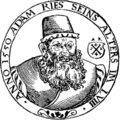Template:Selected anniversaries/March 30: Difference between revisions
No edit summary |
No edit summary |
||
| Line 60: | Line 60: | ||
||1929: Ilya Piatetski-Shapiro born ... mathematician. During a career that spanned 60 years he made major contributions to applied science as well as pure mathematics. In the last forty years his research focused on pure mathematics; in particular, analytic number theory, group representations and algebraic geometry. His main contribution and impact was in the area of automorphic forms and L-functions. Pic. | ||1929: Ilya Piatetski-Shapiro born ... mathematician. During a career that spanned 60 years he made major contributions to applied science as well as pure mathematics. In the last forty years his research focused on pure mathematics; in particular, analytic number theory, group representations and algebraic geometry. His main contribution and impact was in the area of automorphic forms and L-functions. Pic. | ||
||1941: Herbert Freundlich dies ... chemist. Freundlich's main works dealt with the coagulation and stability of colloidal solutions. Pic. | |||
||1944: Charles Vernon Boys dies ... physicist, known for his careful and innovative experimental work. Pic. | ||1944: Charles Vernon Boys dies ... physicist, known for his careful and innovative experimental work. Pic. | ||
Revision as of 14:01, 24 May 2019
1599: Mathematician Adam Ries dies. He wrote textbooks for practical mathematics, promoting the advantages of Arabic/Indian numerals over Roman numerals.
1811: Chemist and academic Robert Bunsen born. He will investigate emission spectra of heated elements, and discover caesium (in 1860) and rubidium (in 1861) with the physicist Gustav Kirchhoff.
1862: Mathematician, philosopher, and crime-fighter Antoine Augustin Cournot uses the ideas of functions and probability to locate and apprehend math criminals.
1886: Mathematician, philosopher, and logician Stanisław Leśniewski born. He will posit three nested formal systems, to which he will give the Greek-derived names of protothetic, ontology, and mereology.
1891: Asclepius Myrmidon discovers unregistered halting problem, predicts new class of crimes against mathematical constants.
1892: Mathematician and academic Stefan Banach born. He will be one of the founders of modern functional analysis.
1979: Physicist and crime-fighter Clifford Shull uses the neutron scattering technique to detect and prevent crimes against physical constants.
1995: Mathematician, physicist, and academic John Lighton Synge dies. He was a prolific author and influential mentor, and is credited with the introduction of a new geometrical approach to the theory of relativity.
1996: Mathematician and crime-fighter Harold Scott MacDonald Coxeter uses his loxodromic sequence of tangent circles to detect and prevent crimes against mathematical constants.
2018: Math photographer Cantor Parabola attends Minicon 53, taking a series of photographs with temporal superimpositions from Minicons 52 and 54.









